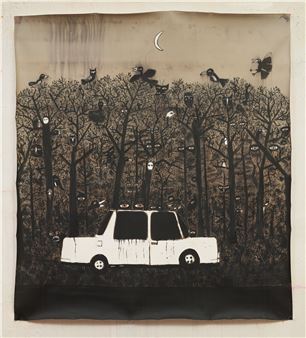The Happy Fainting of Painting #2
вҖңThe Happy Fainting of Painting #2вҖқ is a deliberately didactic image/text arrangement based on a grid purloined from the compositional register of modernism: within this matrix, artworks and theoretical contributions find themselves on a level field, their interplay generating discursivity in a striking manner. This essay-exhibition continues a discussion about and with painting that has previously been documented in the anthology вҖңThe Happy Fainting of PaintingвҖқ (Walther KГ¶nig, 2014) and that was initiated in a first exhibition at BerlinвҖҷs Zwinger Galerie (2012).
In the past (on its path from technique to art) painting has always been able to integrate new art forms and technical resources brought to it from outside in a productive way, gaining something from them. This applies (in different ways for painting, picture and art respectively) to its modes of production and usage, alternative image technologies and visual industries, its history as a medium or tool for capturing pictures and knowledge with regard to a possible collective memory. Whether as a historical meta-level or a traditional picture medium, it is still capable of critically reflecting on and sometimes transcending even dominant visual cultures like advertising. To date, each of its predicted deaths has proved to be, even if only temporarily, an injection of new life. If there is one medium that is kept alive by crises, then it is painting.
Correspondingly, the traditional medium of painting has not been rendered obsolete by new digital technologies and their use in art, as shown by the exhibition вҖңPainting 2.0 вҖ“ Expression in the Information AgeвҖқ. However, the canonization associated with this show needs to be critically revised and followed up. With a narrow focus on painting (and the art business) as a veritable institution, the show blocked access both to the art and to the pictures вҖ“ pictures here meaning visual-cognitive potentials that take effect within an art-specific and/or social framework, not being limited to painting itself.
This is the intention of the five categories introduced by вҖңThe Happy Fainting of Painting #2вҖқ as working hypotheses to stimulate discourse on art, painting and picture theory from within current painterly production. With no claim to covering their theme completely, the sections вҖңThe Painted Word/The Word вҖҳPaintingвҖҷвҖқ, вҖңAfter the Abstraction of AbstractionвҖң, вҖңPost-IronyвҖқ, вҖңCombine Painting/Anything Goes AnythingвҖқ and вҖңRealisms/Documentary PaintingвҖқ are filled to equal degree with artistic and theoretical contributions by artists, theorists, and others interested in this media situation. However much it may break down into individual cases of picture and opinion, the exhibition adds up to a many-voiced tableau of new points of reference and interrelations.

Recommended for you
вҖңThe Happy Fainting of Painting #2вҖқ is a deliberately didactic image/text arrangement based on a grid purloined from the compositional register of modernism: within this matrix, artworks and theoretical contributions find themselves on a level field, their interplay generating discursivity in a striking manner. This essay-exhibition continues a discussion about and with painting that has previously been documented in the anthology вҖңThe Happy Fainting of PaintingвҖқ (Walther KГ¶nig, 2014) and that was initiated in a first exhibition at BerlinвҖҷs Zwinger Galerie (2012).
In the past (on its path from technique to art) painting has always been able to integrate new art forms and technical resources brought to it from outside in a productive way, gaining something from them. This applies (in different ways for painting, picture and art respectively) to its modes of production and usage, alternative image technologies and visual industries, its history as a medium or tool for capturing pictures and knowledge with regard to a possible collective memory. Whether as a historical meta-level or a traditional picture medium, it is still capable of critically reflecting on and sometimes transcending even dominant visual cultures like advertising. To date, each of its predicted deaths has proved to be, even if only temporarily, an injection of new life. If there is one medium that is kept alive by crises, then it is painting.
Correspondingly, the traditional medium of painting has not been rendered obsolete by new digital technologies and their use in art, as shown by the exhibition вҖңPainting 2.0 вҖ“ Expression in the Information AgeвҖқ. However, the canonization associated with this show needs to be critically revised and followed up. With a narrow focus on painting (and the art business) as a veritable institution, the show blocked access both to the art and to the pictures вҖ“ pictures here meaning visual-cognitive potentials that take effect within an art-specific and/or social framework, not being limited to painting itself.
This is the intention of the five categories introduced by вҖңThe Happy Fainting of Painting #2вҖқ as working hypotheses to stimulate discourse on art, painting and picture theory from within current painterly production. With no claim to covering their theme completely, the sections вҖңThe Painted Word/The Word вҖҳPaintingвҖҷвҖқ, вҖңAfter the Abstraction of AbstractionвҖң, вҖңPost-IronyвҖқ, вҖңCombine Painting/Anything Goes AnythingвҖқ and вҖңRealisms/Documentary PaintingвҖқ are filled to equal degree with artistic and theoretical contributions by artists, theorists, and others interested in this media situation. However much it may break down into individual cases of picture and opinion, the exhibition adds up to a many-voiced tableau of new points of reference and interrelations.
Artists on show
- Anna Meyer
- Ariane Müller
- Art & Language
- Avery Singer
- Berthold Reiss
- Birgit Megerle
- Chris Reinecke
- Christine Lemke
- Claudia Kugler
- Dominik Sittig
- Elke Krystufek
- Ellen Gronemeyer
- Gunter Reski
- Heinrich Dunst
- Josef Bauer
- Lin May Saeed
- Lutz Braun
- Marcus Weber
- Olga Balema
- Paul Sochacki
- Pieter Schoolwerth
- Robert Müller
- Tim Berresheim
- Ulrich Lamsfuss
















